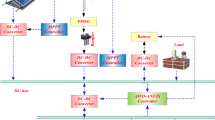Abstract
The solar energy and wind energy are two natural, renewable energy resources for the mankind, for the energy supply without hassles that provided an avenue for its utilization. For the efficient of the resources, wind power generation is one of the options in association with a photovoltaic system for preserving solar energy. Hence the current system requires technology to be involved to control the operation to satisfy the major concern as initially a combinational hybrid system to keep track maximum power, DC voltage input and trade-off between renewable energy delivered for interconnections. The fluctuation in power for interconnection can be minimized by adaptive neuro fuzzy interference method (ANFIS) dependent maximum power point tracking (MPPT) system and microscopically trusted ANFIS based system. In this paper the hybrid MPPT controllers are compared that is with perturb-observe (P&O) and tip speed ratio (TSR) as one set of MPPT controller and another side incremental conductance method (ICM) and hill climb search (HCS) both the controllers are tested with the ANFIS. The proposed system to satisfy the defined objectives is modeled using MATLAB/SIMULINK software by connecting power grid system to inverter influenced by ANFIS controller.






























Similar content being viewed by others
Explore related subjects
Discover the latest articles, news and stories from top researchers in related subjects.Change history
06 June 2022
This article has been retracted. Please see the Retraction Notice for more detail: https://doi.org/10.1007/s12652-022-04081-8
References
Abdullah MA, Yatim AHM, Tan CW, Saidur R (2012) A survey of most extreme power point following calculations for wind vitality frameworks. Renew Sustain Energy Rev 16:3220–3227
Ahmed NA, Al-Othman AK, AlRashidi MR (2011) Development of a productive utility intelligent joined breeze/photovoltaic/energy component control framework with MPPT and DC transport voltage guideline. Electr Power Syst Res 81:1096–1106
Aldobhani AMS, John R (2008) Maximum power point following of PV framework utilizing ANFIS expectation and fuzzy logic following. In: Proceedings of International Multi meeting. Designers and Computer Scientists (IMECS), HonKong, Mar 19–21, 2008, vol II, CD-ROM
Baghat ABG, Helwa NH, Ahmad GE, Shenawy ET (2005) Maximum power point following controller for PV frameworks utilizing neural systems. Renew Vitality 30:1257–1268
Chaterjee AS, Iqbal A (2010) Fuzzy logic control plot for sun powered photograph voltaic framework for most extreme power point tracker. Int J Sustain Vitality 29(4):245–255
de Medeiros Torres A, Antunes FLM, dos Reis FS (1998) An artificial neural system based continuous most extreme power following controller for associating a PV framework to the matrix. In: Proc. IEEE 24th Ann. Conf. Mechanical Electronics Society, vol 1, pp 554–558
Kumar V, Singh M (2019) Sensorless DC-link control approach for three-phase grid integrated PV system. Int J Electr Power Energy Syst 112:309–318
Mellit A, Saglam S, Kalogirou SA (2013) Artificial neural system based model for evaluating the created intensity of a photovoltaic module. Renew Vitality 60:71–78
Padmaja A, Srikanth M (2015) Structure of MPPT controller utilizing ANFIS and HOMER based affectability investigation for MXS 60 PV module. Int J Innov Res Adv Eng (IJIRAE) 2(11):2349–2363
Pankow Y (2005) Étude de l'intégration de la creation décentraliséedansunréseaubasse strain Application aux générateursphotovoltaïques. Diss. Thèse de doctorat Center national de recherché technologique de Lille
Papadopoulos DP, Dermentzoglou JCh (2002) Economic reasonability investigation of arranged WEC system establishments for electrical power generation. Renew Vitality 25(2):199–217
Pavan Kumar Naidu R, Meikandasivam S (2018) ICM based ANFIS MPPT controller for grid connected photovoltaic system. Int J Eng Technol 7(3):1508–1513
Radwan AAA, Mohamed YARI (2019) Grid-connected wind-solar cogeneration using back-to-back voltage-source converters. IEEE Trans Sustain Energy 11(1):315–325
Rashid G, Ali MH (2015) Transient stability enhancement of doubly fed induction machine-based wind generator by bridge-type fault current limiter. IEEE Trans Energy Convers 30(3):939–947
Rubbia C (2006) Today the universe of tomorrow—the vitality challenge. Energy Convers 47:2695–2697
Salam Z, Ahmed J, Merugu BS (2013) The use of delicate registering techniques for MPPT of PV framework: a mechanical and status audit. Appl Vitality 107:135–148
Sengar S, Liu X (2020) Ensemble approach for short term load forecasting in wind energy system using hybrid algorithm. J Ambient Intell Humaniz Comput. https://doi.org/10.1007/s12652-020-01866-7
Thongam JS, Ouhrouche M (2011) MPPT control techniques in wind vitality change frameworks. In: InTech book part 15 (fundamental and propelled points in wind control), pp 339–360
Veerachary M, Senjyu T, Uezato K (2003) Neural-arrange based most extreme power-point following of coupled-inductor interleaved-help converter-provided PV framework utilizing fuzzy controller. IEEE Trans Ind Electron 50(4):749–758
Vijaya Bhaskar K, Lokanadham M (2012) Incremental conductance based maximum power point tracking (MPPT) for photovoltaic system. Int J Eng Res Appl (IJERA) 2(2):1420–1424
Yi Hong Y, Lu S, Chiou CS (2009) MPPT for PM wind generator utilizing inclination estimation. Energy Convers Manag 50:82–89
Author information
Authors and Affiliations
Corresponding author
Additional information
Publisher's Note
Springer Nature remains neutral with regard to jurisdictional claims in published maps and institutional affiliations.
This article has been retracted. Please see the retraction notice for more detail:https://doi.org/10.1007/s12652-022-04081-8
About this article
Cite this article
Naidu, R.P.K., Meikandasivam, S. RETRACTED ARTICLE: Performance investigation of grid integrated photovoltaic/wind energy systems using ANFIS based hybrid MPPT controller. J Ambient Intell Human Comput 12, 5147–5159 (2021). https://doi.org/10.1007/s12652-020-01967-3
Received:
Accepted:
Published:
Issue Date:
DOI: https://doi.org/10.1007/s12652-020-01967-3




